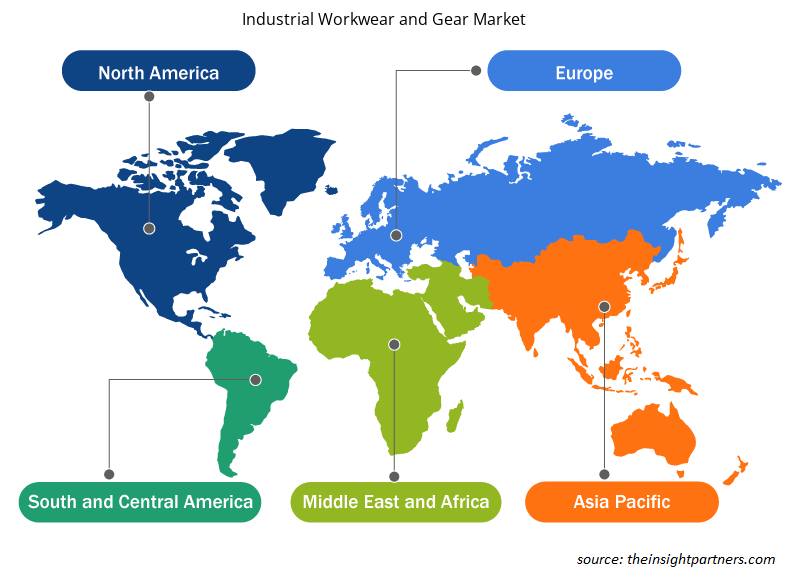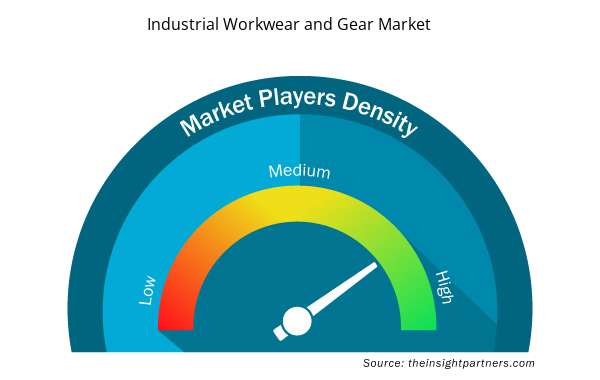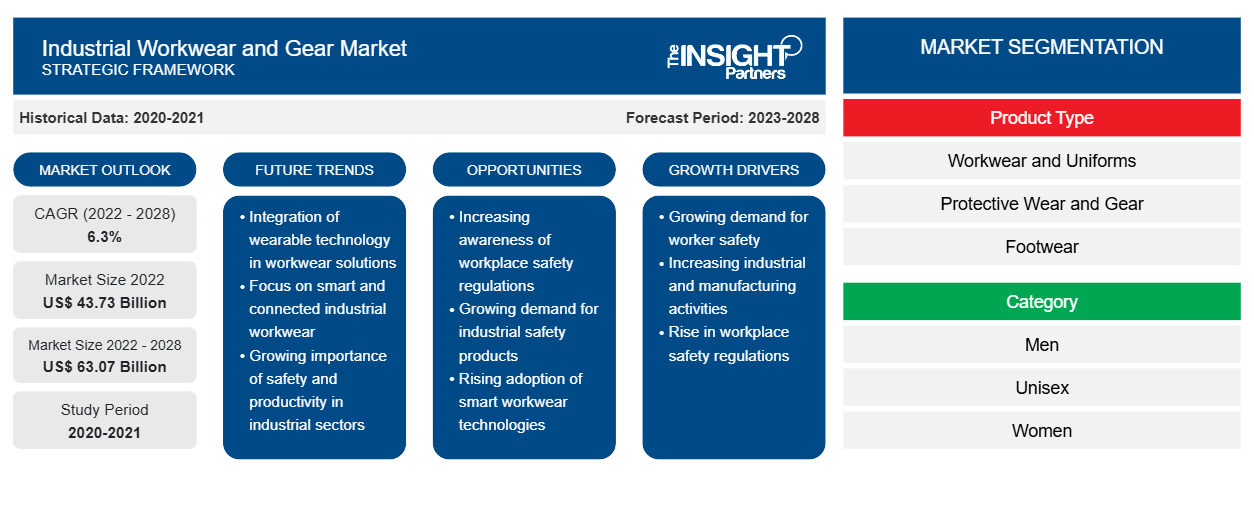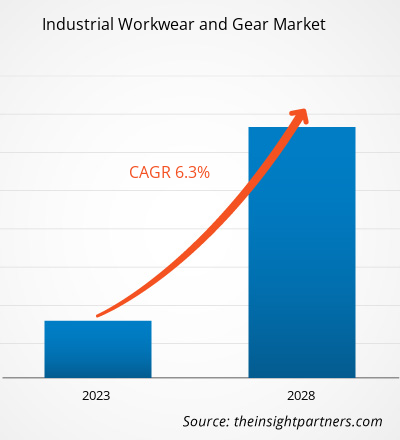Si prevede che il mercato degli indumenti e degli equipaggiamenti da lavoro industriali crescerà da 43.725,45 milioni di dollari nel 2022 a 63.072,02 milioni di dollari entro il 2028; si prevede che il mercato registrerà un CAGR del 6,3% dal 2022 al 2028.
I prodotti per l'abbigliamento da lavoro industriale aiutano a garantire la sicurezza dei lavoratori in contesti industriali. Sono progettati specificamente per assorbire urti o qualsiasi tipo di impatto che possa causare lesioni a dipendenti e operai. Inoltre, sono realizzati in materiali resistenti all'usura, agli agenti chimici e alle fiamme, offrendo una protezione efficace da diversi pericoli. I produttori di abbigliamento da lavoro industriale stanno lanciando prodotti convenienti con funzionalità avanzate per soddisfare la crescente domanda dei consumatori, che dovrebbe offrire immense opportunità per la crescita del mercato dell'abbigliamento da lavoro e dell'attrezzatura industriale nei prossimi anni.
Impatto della pandemia di COVID-19 sul mercato degli indumenti da lavoro e degli equipaggiamenti industriali
Nel 2020, vari settori hanno dovuto rallentare le proprie attività a causa di interruzioni nelle catene di valore e di fornitura causate dalla chiusura dei confini nazionali e internazionali. La pandemia di COVID-19 ha avuto un impatto negativo sulle economie e sui settori a causa di blocchi, divieti di viaggio e chiusure aziendali. Le restrizioni imposte dalle autorità governative hanno portato a interruzioni nelle catene di fornitura di materie prime chiave e irregolarità nei processi di produzione, che hanno avuto un impatto diretto sulle industrie manifatturiere, ostacolando così la produzione e la domanda di indumenti da lavoro industriali. Tuttavia, la pandemia di COVID-19 ha avuto anche un impatto favorevole sul mercato degli indumenti da lavoro e delle attrezzature industriali in una certa misura. La domanda di kit di dispositivi di protezione individuale (DPI) è aumentata nei laboratori di ricerca contribuendo allo sviluppo di vaccini per diverse varianti di SARS-CoV-2, per prevenire l'esposizione diretta dei dipendenti al virus. Con un brusco aumento della domanda, i produttori di DPI hanno aumentato le loro capacità produttive.
Personalizza questo report in base alle tue esigenze
Riceverai la personalizzazione gratuita di qualsiasi report, comprese parti di questo report, o analisi a livello nazionale, pacchetto dati Excel, oltre a usufruire di grandi offerte e sconti per start-up e università
- Scopri le principali tendenze di mercato in questo rapporto.Questo campione GRATUITO includerà analisi di dati che spaziano dalle tendenze di mercato alle stime e alle previsioni.
Approfondimenti di mercato
La crescente domanda delle economie emergenti alimenterà la crescita del mercato nei prossimi anni
I governi delle economie emergenti stanno aumentando la loro attenzione sullo sviluppo delle infrastrutture. Ad esempio, a novembre 2021, India, Stati Uniti, Israele ed Emirati Arabi Uniti hanno istituito un nuovo forum economico quadrilaterale per concentrarsi sui progetti di sviluppo delle infrastrutture e rafforzare la cooperazione bilaterale. È probabile che tali iniziative governative stimolino la domanda di indumenti da lavoro e attrezzature industriali nelle economie emergenti. Inoltre, il numero di progetti infrastrutturali, come Tuban Olefin Complex Development Project (Indonesia), Singapore Deep Tunnel Sewerage System e Shenzhong Link (Cina), sta aumentando nei paesi in via di sviluppo, il che dovrebbe alimentare la domanda di indumenti da lavoro e attrezzature industriali per garantire la sicurezza dei lavoratori. Pertanto, si prevede che i rapidi sviluppi nei settori industriali nelle economie emergenti creeranno opportunità redditizie per il mercato degli indumenti da lavoro e delle attrezzature industriali durante il periodo di previsione.
Informazioni basate sul tipo di prodotto
In base al tipo, il mercato degli indumenti da lavoro e delle attrezzature industriali è segmentato in indumenti da lavoro e uniformi, indumenti e attrezzature protettive, calzature, guanti e altri. Si prevede che il segmento degli indumenti e delle attrezzature protettive registrerà il CAGR più elevato durante il periodo di previsione. L'Organizzazione Internazionale del Lavoro conduce un codice di condotta per la sicurezza e la salute sul lavoro dei dipendenti in tutto il mondo. I settori dell'estrazione del carbone, della produzione chimica e della produzione di energia, tra gli altri, seguono le normative stabilite da tali enti normativi. L'obbligo di conformità alle normative relative alla protezione dei dipendenti determina la domanda di indumenti e attrezzature protettive.
Approfondimenti basati sul settore di utilizzo finale
In base al settore di utilizzo finale, il mercato degli indumenti da lavoro e degli equipaggiamenti industriali è suddiviso in edilizia, petrolio e gas, prodotti chimici, industrie pesanti e manifatturiere, estrazione mineraria, prodotti farmaceutici e altri. Il segmento delle industrie pesanti e manifatturiere ha detenuto la quota maggiore del mercato nel 2021. L'industria manifatturiera comprende aziende che producono cellulosa e carta, macchinari e attrezzature, prodotti polimerici, prodotti minerali non metallici, mobili, gomma e prodotti in legno. L'esposizione continua dei lavoratori ad ambienti pericolosi e la mancanza di calzature protettive per i lavoratori sono state per anni la causa principale di incidenti industriali nel settore manifatturiero. Tute protettive, guanti e manicotti, berretti/cappelli, cappotti, giacche, camicie, calzini, giacche softshell, felpe, pantaloni, maschere facciali, visiere, gilet e stivali e scarpe protettive con puntale sono specificamente progettati per salvaguardare le parti superiori e inferiori del corpo dei lavoratori delle industrie pesanti e dei settori manifatturieri.
I principali attori che operano nel mercato dell'abbigliamento e dell'attrezzatura da lavoro industriale includono Carhartt, Inc.; ARAMARK; Alsico Group; A. LAFONT SAS; Honeywell International Inc.; Hultafors Group AB; Lakeland Industries Inc.; VF Corporation; Ansell Ltd.; Hultafors Group AB; e Mustang Workwear. Questi attori si concentrano sulla fornitura di prodotti di alta qualità per soddisfare le richieste dei clienti. Si concentrano anche su strategie come investimenti in attività di ricerca e sviluppo e lanci di nuovi prodotti.
Approfondimenti regionali sul mercato degli indumenti da lavoro e degli equipaggiamenti industriali
Le tendenze regionali e i fattori che influenzano il mercato dell'abbigliamento da lavoro e dell'attrezzatura industriale durante il periodo di previsione sono stati ampiamente spiegati dagli analisti di Insight Partners. Questa sezione discute anche i segmenti e la geografia del mercato dell'abbigliamento da lavoro e dell'attrezzatura industriale in Nord America, Europa, Asia Pacifico, Medio Oriente e Africa e America meridionale e centrale.

- Ottieni i dati specifici regionali per il mercato degli indumenti da lavoro e degli attrezzi industriali
Ambito del rapporto sul mercato degli indumenti da lavoro e degli attrezzi industriali
| Attributo del report | Dettagli |
|---|---|
| Dimensioni del mercato nel 2022 | 43,73 miliardi di dollari USA |
| Dimensioni del mercato entro il 2028 | 63,07 miliardi di dollari USA |
| CAGR globale (2022 - 2028) | 6,3% |
| Dati storici | 2020-2021 |
| Periodo di previsione | 2023-2028 |
| Segmenti coperti | Per tipo di prodotto
|
| Regioni e Paesi coperti | America del Nord
|
| Leader di mercato e profili aziendali chiave |
|
Densità degli operatori del mercato degli indumenti da lavoro e degli equipaggiamenti industriali: comprendere il suo impatto sulle dinamiche aziendali
Il mercato dell'abbigliamento da lavoro e dell'attrezzatura industriale sta crescendo rapidamente, spinto dalla crescente domanda degli utenti finali dovuta a fattori quali l'evoluzione delle preferenze dei consumatori, i progressi tecnologici e una maggiore consapevolezza dei vantaggi del prodotto. Con l'aumento della domanda, le aziende stanno ampliando le loro offerte, innovando per soddisfare le esigenze dei consumatori e capitalizzando sulle tendenze emergenti, il che alimenta ulteriormente la crescita del mercato.
La densità degli operatori di mercato si riferisce alla distribuzione di aziende o società che operano in un particolare mercato o settore. Indica quanti concorrenti (operatori di mercato) sono presenti in un dato spazio di mercato in relazione alle sue dimensioni o al valore di mercato totale.
Le principali aziende che operano nel mercato degli indumenti e degli equipaggiamenti da lavoro industriali sono:
- WATTANA GmbH
- Azienda Carson GmbH
- Abbigliamento protettivo HB GmbH & Co. KG
- Engelbert Strauss GmbH und Co. KG
- 3 milioni
Disclaimer : le aziende elencate sopra non sono classificate secondo un ordine particolare.

- Ottieni una panoramica dei principali attori del mercato degli indumenti da lavoro e degli equipaggiamenti industriali
Segnala i riflettori
- Tendenze industriali progressive nel mercato degli indumenti e degli equipaggiamenti da lavoro industriali per aiutare gli operatori a sviluppare strategie efficaci a lungo termine
- Strategie di crescita aziendale adottate dalle aziende per garantire la crescita nei mercati sviluppati e in via di sviluppo
- Analisi quantitativa del mercato degli indumenti da lavoro e degli equipaggiamenti industriali dal 2022 al 2028
- Stima della domanda globale di indumenti e attrezzature da lavoro industriali
- Analisi delle cinque forze di Porter per illustrare l'efficacia di acquirenti e fornitori di indumenti e attrezzature da lavoro industriali
- Sviluppi recenti per comprendere lo scenario competitivo del mercato
- Tendenze e prospettive del mercato, insieme ai fattori che guidano e frenano la crescita del mercato degli indumenti e degli equipaggiamenti da lavoro industriali
- Assistenza nel processo decisionale evidenziando le strategie di mercato che sostengono l'interesse commerciale
- Le dimensioni del mercato degli indumenti da lavoro e degli equipaggiamenti industriali in vari nodi
- Panoramica dettagliata e segmentazione del mercato, nonché dinamiche del settore degli indumenti da lavoro e degli ingranaggi industriali
- Dimensioni del mercato degli indumenti e degli equipaggiamenti da lavoro industriali in varie regioni con promettenti opportunità di crescita
Profili aziendali
- Carhartt, Inc.
- ARAMARCO
- Gruppo Alsico
- A. LAFONT SAS
- Honeywell International Inc.
- Gruppo Hultafors AB
- Società per azioni Lakeland Industries Inc.
- Società per azioni VF Corporation; Ansell Ltd.
- Gruppo Hultafors AB
- Abbigliamento da lavoro Mustang
- Analisi storica (2 anni), anno base, previsione (7 anni) con CAGR
- Analisi PEST e SWOT
- Valore/volume delle dimensioni del mercato - Globale, regionale, nazionale
- Industria e panorama competitivo
- Set di dati Excel



Report Coverage
Revenue forecast, Company Analysis, Industry landscape, Growth factors, and Trends

Segment Covered
This text is related
to segments covered.

Regional Scope
North America, Europe, Asia Pacific, Middle East & Africa, South & Central America

Country Scope
This text is related
to country scope.
Domande frequenti
An increase in industrial accidents and work-related mortality and introducing a stringent regulatory framework for the industrial sector are some of the key driving factors for the industrial workwear and gear market.
Based on category, unisex is the fastest-growing segment in the industrial workwear and gear market due to the increasing implementation of gender-neutral dress codes at workplaces.
Europe accounted for the largest share of the global industrial workwear and gear market. The increasing number of construction sites in Europe and the uncertainty associated with the pandemic have resulted in an urge for effective protective workwear.
Based on the product type, the workwear and uniforms segment accounted for the largest revenue share as the internal policies at various industrial workplace allow employers to set dress codes for employees which drives the growth of the segment.
The increasing development in various industrial sectors of emerging economies has propelled the need to maintain the safety of workers while working. Thus, rapid development in industrial sectors of emerging economies is anticipated to create lucrative opportunities for the industrial workwear and gear market during the forecast period.
The major players operating in the global industrial workwear and gear market are Carhartt, Inc.; ARAMARK; Alsico Group; A. LAFONT SAS; Honeywell International Inc.; Hultafors Group AB; Lakeland Industries Inc.; VF Corporation; Ansell Ltd.; Hultafors Group AB; and Mustang Workwear among few others.
Trends and growth analysis reports related to Consumer Goods : READ MORE..
The List of Companies - Industrial Workwear and Gear Market
- WATTANA GmbH
- Carson Company GmbH
- HB Protective Wear GmbH & Co. KG
- Engelbert Strauss GmbH and Co. KG
- 3M
- Carhartt, Inc.
- Alsico Group
- A. LAFONT SAS
- Hultafors Group AB
- Honeywell International Inc.
The Insight Partners performs research in 4 major stages: Data Collection & Secondary Research, Primary Research, Data Analysis and Data Triangulation & Final Review.
- Data Collection and Secondary Research:
As a market research and consulting firm operating from a decade, we have published and advised several client across the globe. First step for any study will start with an assessment of currently available data and insights from existing reports. Further, historical and current market information is collected from Investor Presentations, Annual Reports, SEC Filings, etc., and other information related to company’s performance and market positioning are gathered from Paid Databases (Factiva, Hoovers, and Reuters) and various other publications available in public domain.
Several associations trade associates, technical forums, institutes, societies and organization are accessed to gain technical as well as market related insights through their publications such as research papers, blogs and press releases related to the studies are referred to get cues about the market. Further, white papers, journals, magazines, and other news articles published in last 3 years are scrutinized and analyzed to understand the current market trends.
- Primary Research:
The primarily interview analysis comprise of data obtained from industry participants interview and answers to survey questions gathered by in-house primary team.
For primary research, interviews are conducted with industry experts/CEOs/Marketing Managers/VPs/Subject Matter Experts from both demand and supply side to get a 360-degree view of the market. The primary team conducts several interviews based on the complexity of the markets to understand the various market trends and dynamics which makes research more credible and precise.
A typical research interview fulfils the following functions:
- Provides first-hand information on the market size, market trends, growth trends, competitive landscape, and outlook
- Validates and strengthens in-house secondary research findings
- Develops the analysis team’s expertise and market understanding
Primary research involves email interactions and telephone interviews for each market, category, segment, and sub-segment across geographies. The participants who typically take part in such a process include, but are not limited to:
- Industry participants: VPs, business development managers, market intelligence managers and national sales managers
- Outside experts: Valuation experts, research analysts and key opinion leaders specializing in the electronics and semiconductor industry.
Below is the breakup of our primary respondents by company, designation, and region:

Once we receive the confirmation from primary research sources or primary respondents, we finalize the base year market estimation and forecast the data as per the macroeconomic and microeconomic factors assessed during data collection.
- Data Analysis:
Once data is validated through both secondary as well as primary respondents, we finalize the market estimations by hypothesis formulation and factor analysis at regional and country level.
- Macro-Economic Factor Analysis:
We analyse macroeconomic indicators such the gross domestic product (GDP), increase in the demand for goods and services across industries, technological advancement, regional economic growth, governmental policies, the influence of COVID-19, PEST analysis, and other aspects. This analysis aids in setting benchmarks for various nations/regions and approximating market splits. Additionally, the general trend of the aforementioned components aid in determining the market's development possibilities.
- Country Level Data:
Various factors that are especially aligned to the country are taken into account to determine the market size for a certain area and country, including the presence of vendors, such as headquarters and offices, the country's GDP, demand patterns, and industry growth. To comprehend the market dynamics for the nation, a number of growth variables, inhibitors, application areas, and current market trends are researched. The aforementioned elements aid in determining the country's overall market's growth potential.
- Company Profile:
The “Table of Contents” is formulated by listing and analyzing more than 25 - 30 companies operating in the market ecosystem across geographies. However, we profile only 10 companies as a standard practice in our syndicate reports. These 10 companies comprise leading, emerging, and regional players. Nonetheless, our analysis is not restricted to the 10 listed companies, we also analyze other companies present in the market to develop a holistic view and understand the prevailing trends. The “Company Profiles” section in the report covers key facts, business description, products & services, financial information, SWOT analysis, and key developments. The financial information presented is extracted from the annual reports and official documents of the publicly listed companies. Upon collecting the information for the sections of respective companies, we verify them via various primary sources and then compile the data in respective company profiles. The company level information helps us in deriving the base number as well as in forecasting the market size.
- Developing Base Number:
Aggregation of sales statistics (2020-2022) and macro-economic factor, and other secondary and primary research insights are utilized to arrive at base number and related market shares for 2022. The data gaps are identified in this step and relevant market data is analyzed, collected from paid primary interviews or databases. On finalizing the base year market size, forecasts are developed on the basis of macro-economic, industry and market growth factors and company level analysis.
- Data Triangulation and Final Review:
The market findings and base year market size calculations are validated from supply as well as demand side. Demand side validations are based on macro-economic factor analysis and benchmarks for respective regions and countries. In case of supply side validations, revenues of major companies are estimated (in case not available) based on industry benchmark, approximate number of employees, product portfolio, and primary interviews revenues are gathered. Further revenue from target product/service segment is assessed to avoid overshooting of market statistics. In case of heavy deviations between supply and demand side values, all thes steps are repeated to achieve synchronization.
We follow an iterative model, wherein we share our research findings with Subject Matter Experts (SME’s) and Key Opinion Leaders (KOLs) until consensus view of the market is not formulated – this model negates any drastic deviation in the opinions of experts. Only validated and universally acceptable research findings are quoted in our reports.
We have important check points that we use to validate our research findings – which we call – data triangulation, where we validate the information, we generate from secondary sources with primary interviews and then we re-validate with our internal data bases and Subject matter experts. This comprehensive model enables us to deliver high quality, reliable data in shortest possible time.


 Ottieni un campione gratuito per questo repot
Ottieni un campione gratuito per questo repot